The Ultimate Guide to Garage Epoxy Floors
Redefining the Modern GarageIntroduction
Over the past decade, garages have evolved from cluttered storage spaces into functional extensions of the home—serving as workshops, gyms, creative studios, or simply immaculate showcases for vehicles.
At the heart of this transformation lies one element that defines the tone of the entire space: the floor.
Concrete, though strong, is porous, dusty, and prone to staining, cracking, and chemical degradation over time. Paints and sealers offer only temporary improvement. For homeowners and businesses seeking a long-term, professional-grade solution, epoxy flooring has become the benchmark for performance, durability, and visual appeal.
This guide explores everything you need to know about garage epoxy floors—from what they are and how they’re installed, to their benefits, costs, and maintenance—providing an in-depth reference for architects, homeowners, and commercial property managers alike.
What is Epoxy Flooring?
The Science Behind Epoxy
Epoxy flooring is a two-part thermosetting polymer system composed of resin and hardener. When these two components are mixed, they chemically react to form a dense, rigid plastic layer that bonds permanently to concrete.
Unlike simple floor paints, epoxy coatings don’t just sit on the surface—they penetrate and fuse with the concrete substrate, creating a monolithic, seamless finish.
The result is a floor that is:
- Chemically resistant
- Highly durable
- Glossy and aesthetically pleasing
- Easy to clean and maintain
Depending on the formulation and thickness, epoxy floors can handle everything from domestic vehicles to industrial machinery and even aircraft hangars.
To read more on epoxies and their usage in flooring systems, we encourage you to read our epoxy flooring technical guide here.
Epoxy vs. Epoxy Paint vs. Polyurethane
It’s important to distinguish true epoxy flooring from “epoxy paint,” a term often misused in retail markets.
Epoxy paint usually contains a small amount of epoxy resin mixed into regular acrylic paint—giving it a tougher finish than latex paint, but nowhere near the performance of industrial-grade epoxy with a massive compressive strength. Professional epoxy flooring, by contrast, is a multi-layered system that may include:
- Primer coat
- Base coat
- Decorative flakes or quartz
- Topcoat (epoxy or polyurethane)
Some installers also use urethane topcoats for enhanced UV and chemical resistance, especially in garages exposed to sunlight or chemicals.
Read our article on garage floor paints Vs epoxies for more information on this topic.
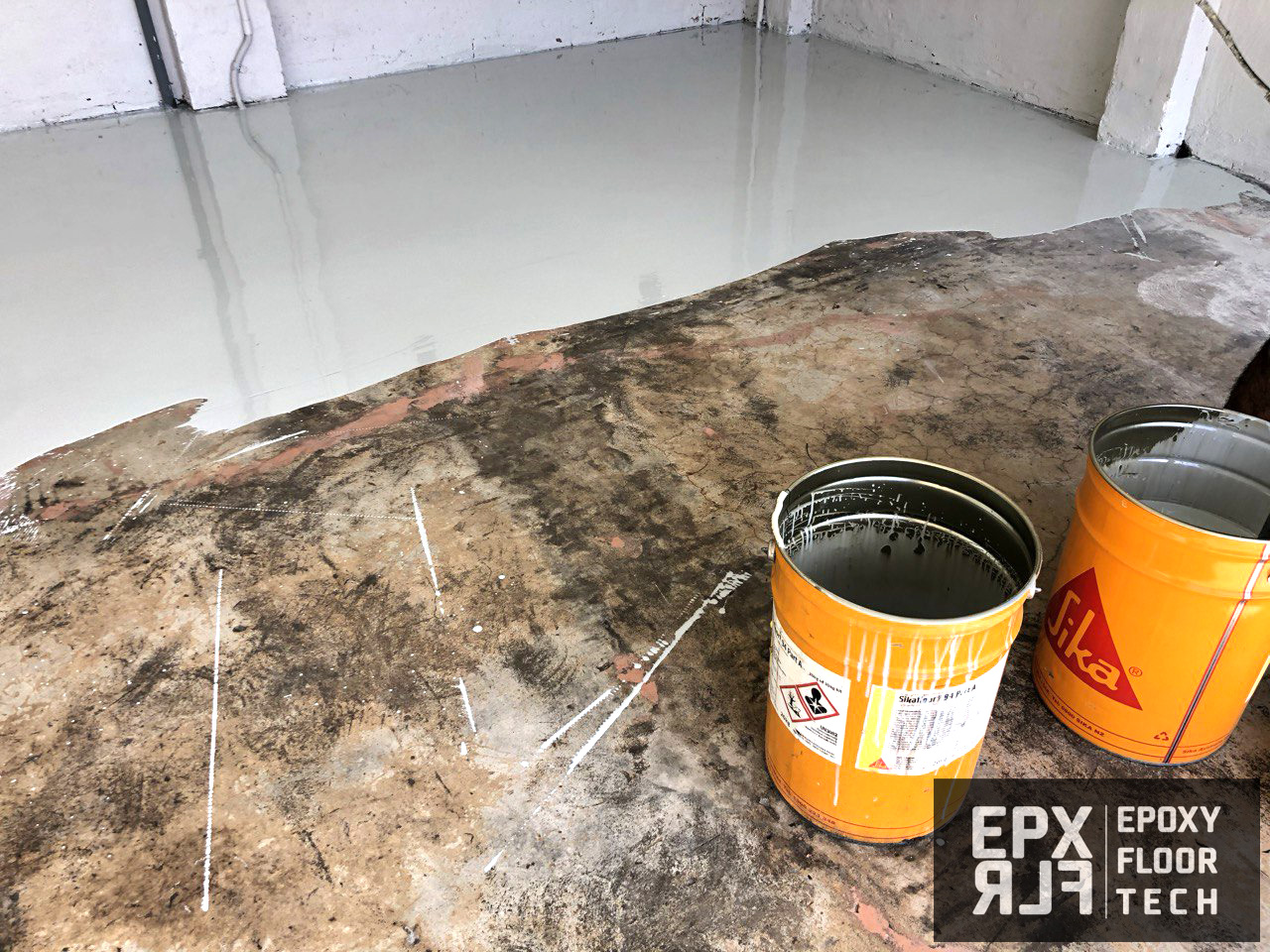
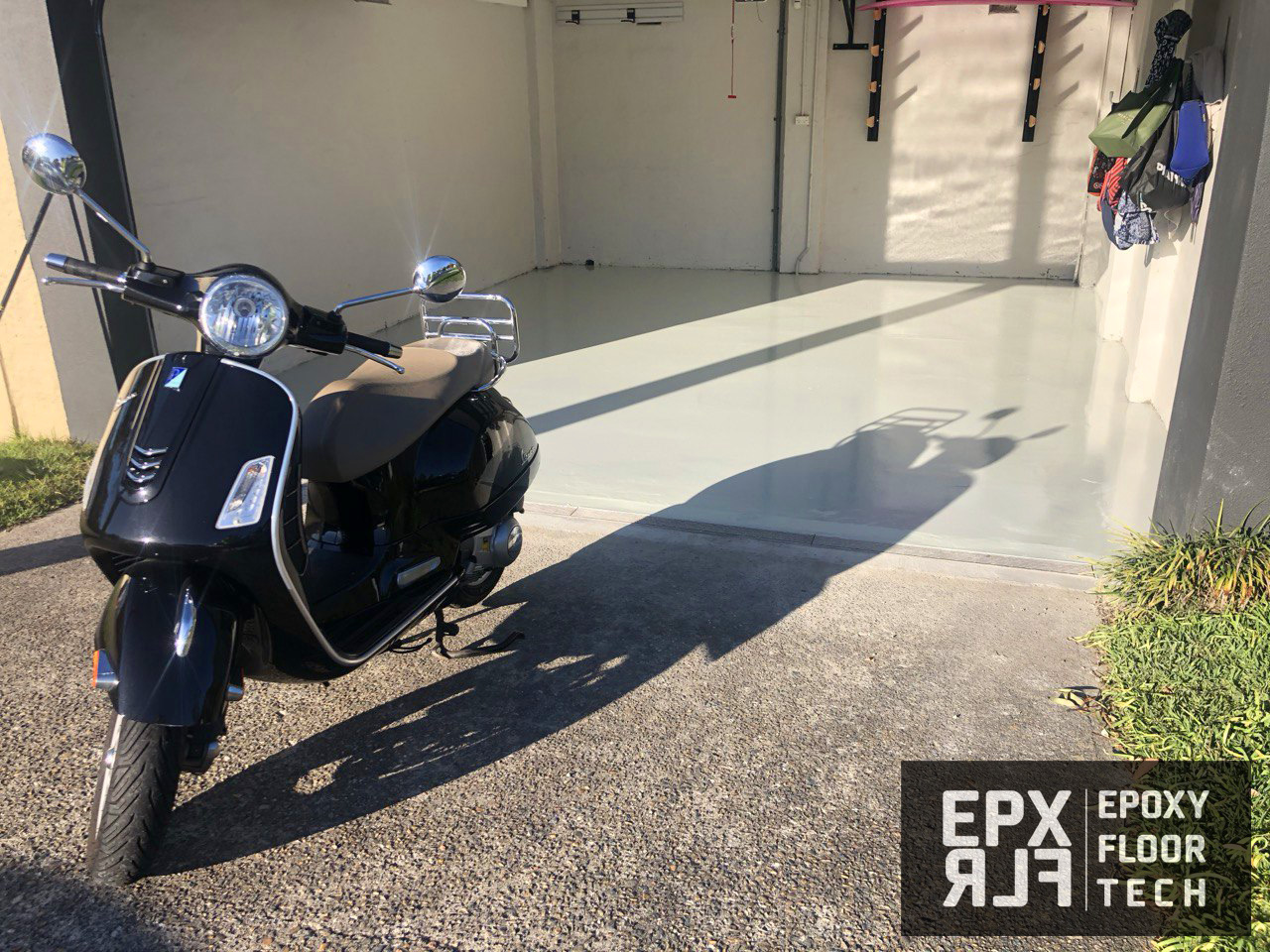
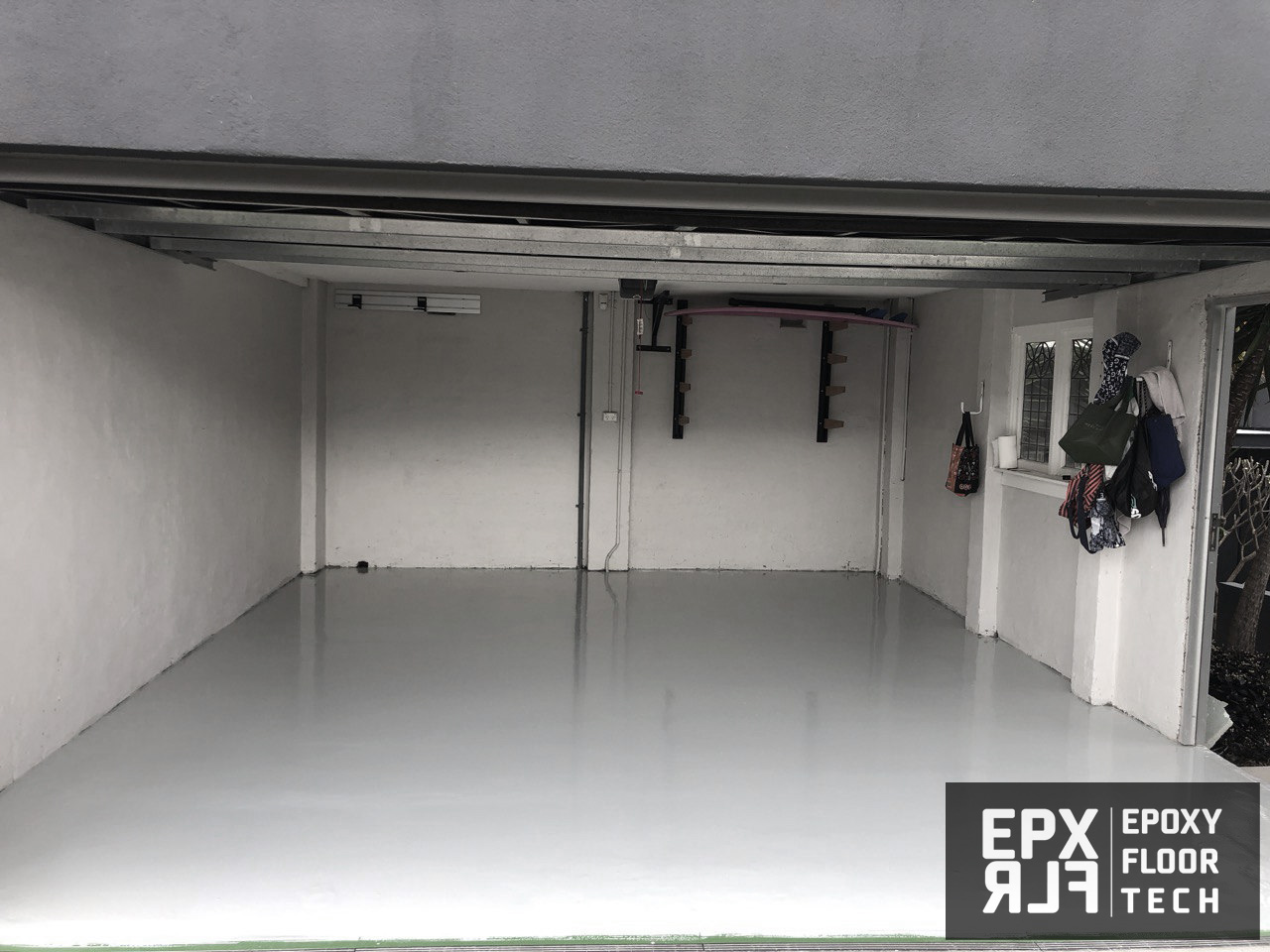
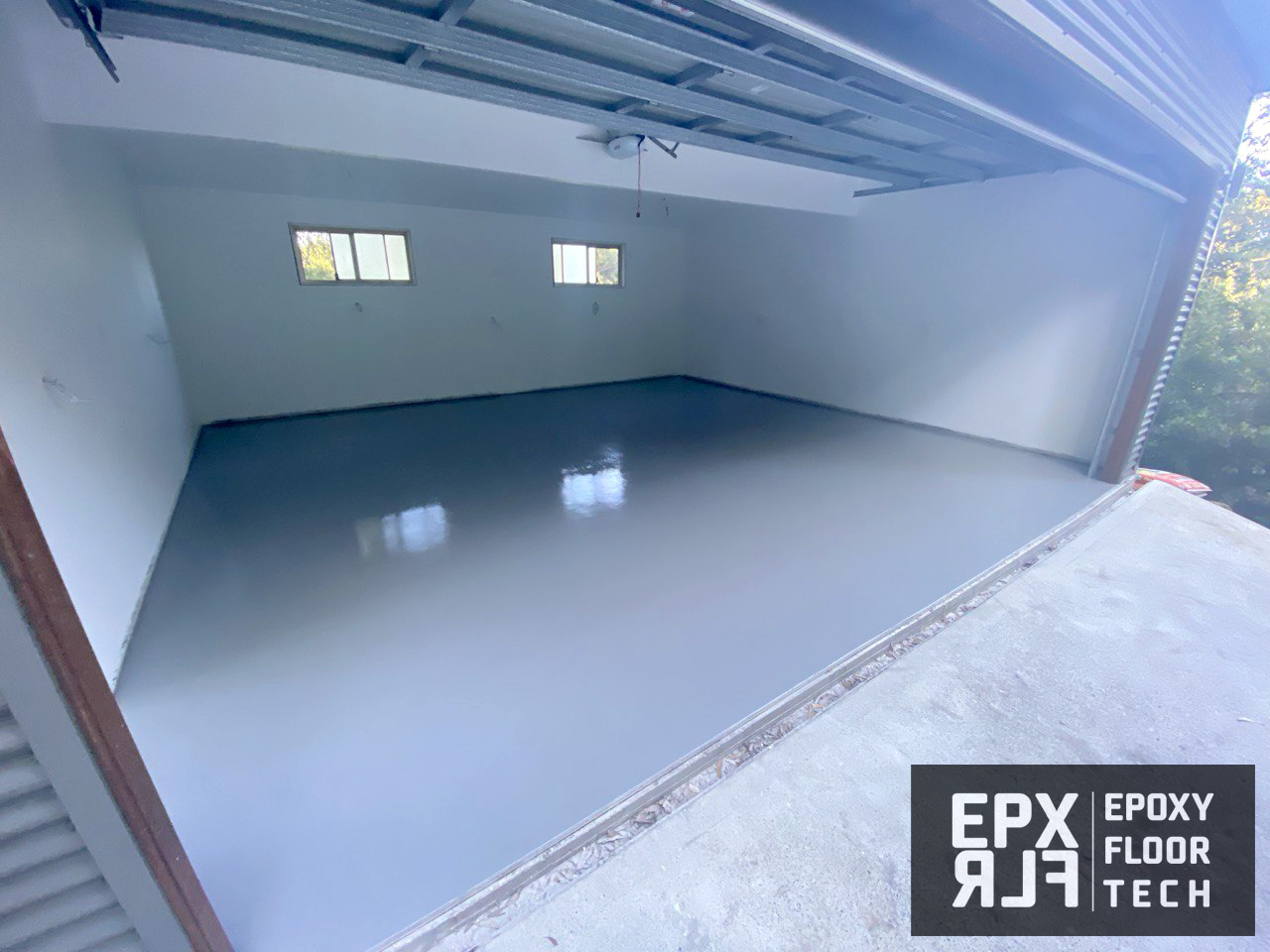
Why Choose Epoxy Flooring for Garages
Garages experience some of the toughest conditions in any home—hot tires, oil drips, brake fluid, dropped tools, and constant mechanical stress.
Epoxy flooring addresses all of these challenges with remarkable resilience.
Let’s explore the key benefits in detail.
- Superior Durability and Load Capacity
Epoxy flooring has a compressive strength often exceeding 80–100 MPa, outperforming uncoated concrete. It resists impacts from tools and equipment, rolling loads from vehicles, and vibration from power tools or machinery.
Unlike paint or sealer that may peel or flake, a properly installed epoxy floor forms a bonded shell that lasts for years under heavy use.
- Chemical and Stain Resistance
Garages are chemical-rich environments: oils, fuels, antifreeze, brake fluid, and cleaning agents all attack concrete over time.
Epoxy flooring creates a non-porous barrier that resists staining, corrosion, and absorption of liquids.
Spills can be wiped away easily without leaving permanent marks or odours.
- Aesthetic Flexibility
Epoxy isn’t just practical—it’s visually transformative.
Modern systems can be tailored with:
- Solid colours for a clean, modern look
- Metallic finishes for luxury garages
- Flake systems (vinyl chips) that add texture and depth
- Quartz or terrazzo blends for decorative appeal
These designs turn an ordinary garage into a space that complements the rest of the home.
- Safety and Slip Resistance
Garage floors frequently encounter water, oil, and dust—all potential slip hazards.
Epoxy systems can be customised with anti-slip aggregates such as silica sand, aluminium oxide, or polymer flakes to improve traction without compromising cleanability.
Installers can achieve targeted slip resistance ratings compliant with AS/NZS 4586, ensuring safety for both vehicles and pedestrians.
- Dust and Moisture Control
Bare concrete continuously releases fine dust known as “concrete efflorescence.”
Epoxy coating seals the surface completely, eliminating dust and preventing moisture penetration from underneath—an essential benefit for garages connected to homes, where dust often migrates indoors.
- Long-Term Cost Efficiency
While epoxy flooring involves a higher initial investment than basic concrete sealing, its longevity (10–20 years) and low maintenance costs make it far more economical over time.
No waxing, polishing, or frequent resealing is required—just routine cleaning and occasional inspection.
Types of Garage Epoxy Systems
Epoxy flooring isn’t one-size-fits-all. The system type depends on the usage intensity, visual goals, and budget.
Below are the most common systems for residential and light-commercial garages:
- Solid Colour Epoxy Coating (2–3 mm)
A smooth, high-gloss finish ideal for standard garages.
It offers excellent chemical resistance and easy cleaning.
Optional non-slip additives can be included for wet areas.
- Epoxy Flake System (3–4 mm)
Perhaps the most popular style for residential garages.
Coloured vinyl flakes are broadcast onto the base coat and sealed under a clear topcoat, giving a decorative terrazzo-like appearance.
Flake floors are excellent for hiding imperfections and adding texture for slip resistance.
- Metallic Epoxy System
A premium finish that uses metallic pigments swirled into the epoxy to create three-dimensional, marble-like effects.
Common in show garages and luxury homes, metallic systems are visually striking but require skilled installation.
- Quartz Epoxy System (4–5 mm)
Combines epoxy resin with fine quartz sand for enhanced durability and traction.
Suitable for workshop-style garages or small commercial auto bays.
- Urethane Cement Hybrid
For industrial garages or automotive workshops, a urethane cement system provides superior resistance to heat and thermal shock (e.g., from hot tires or welding sparks).
It’s more expensive but nearly indestructible under heavy-duty use.
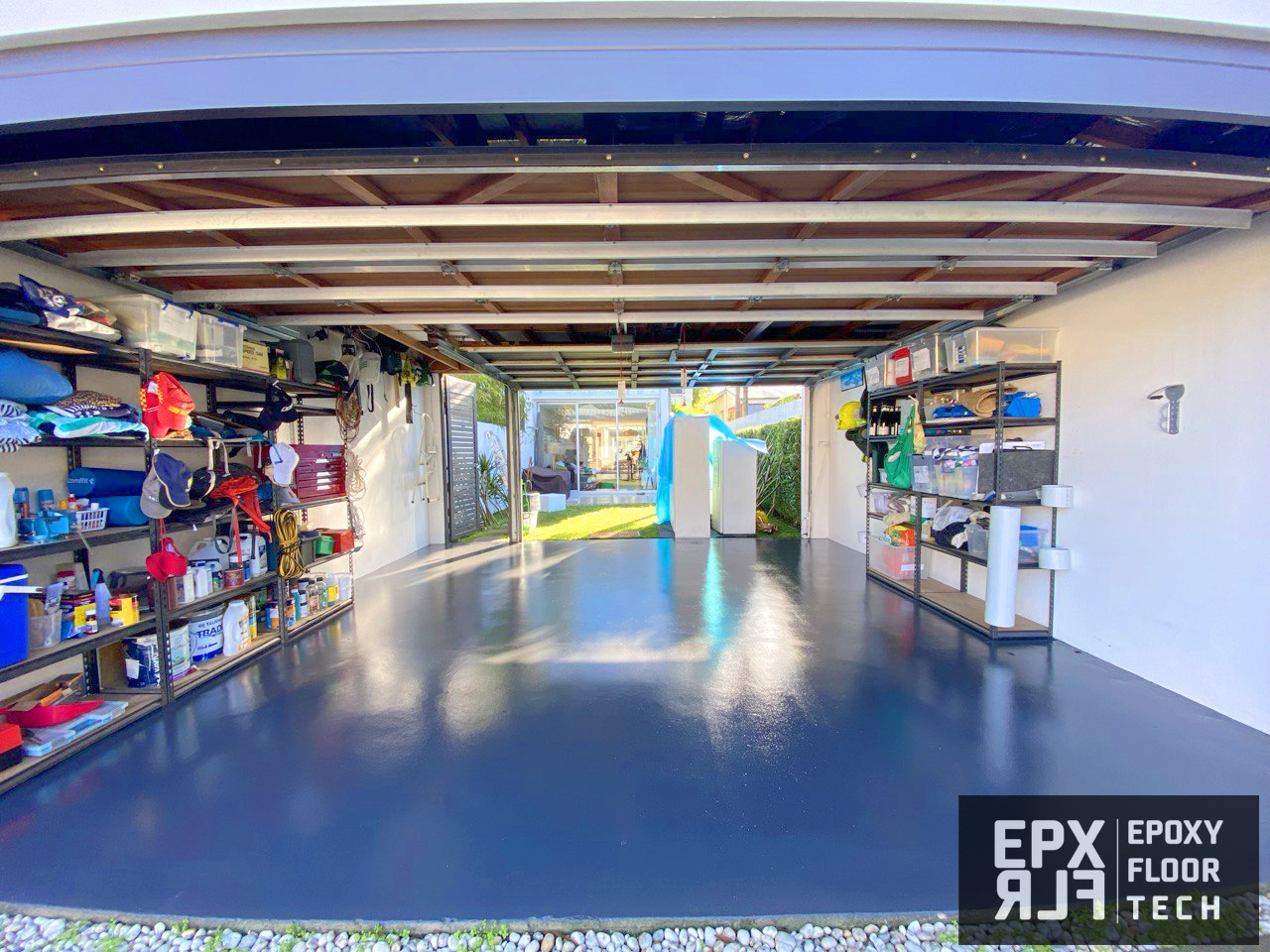
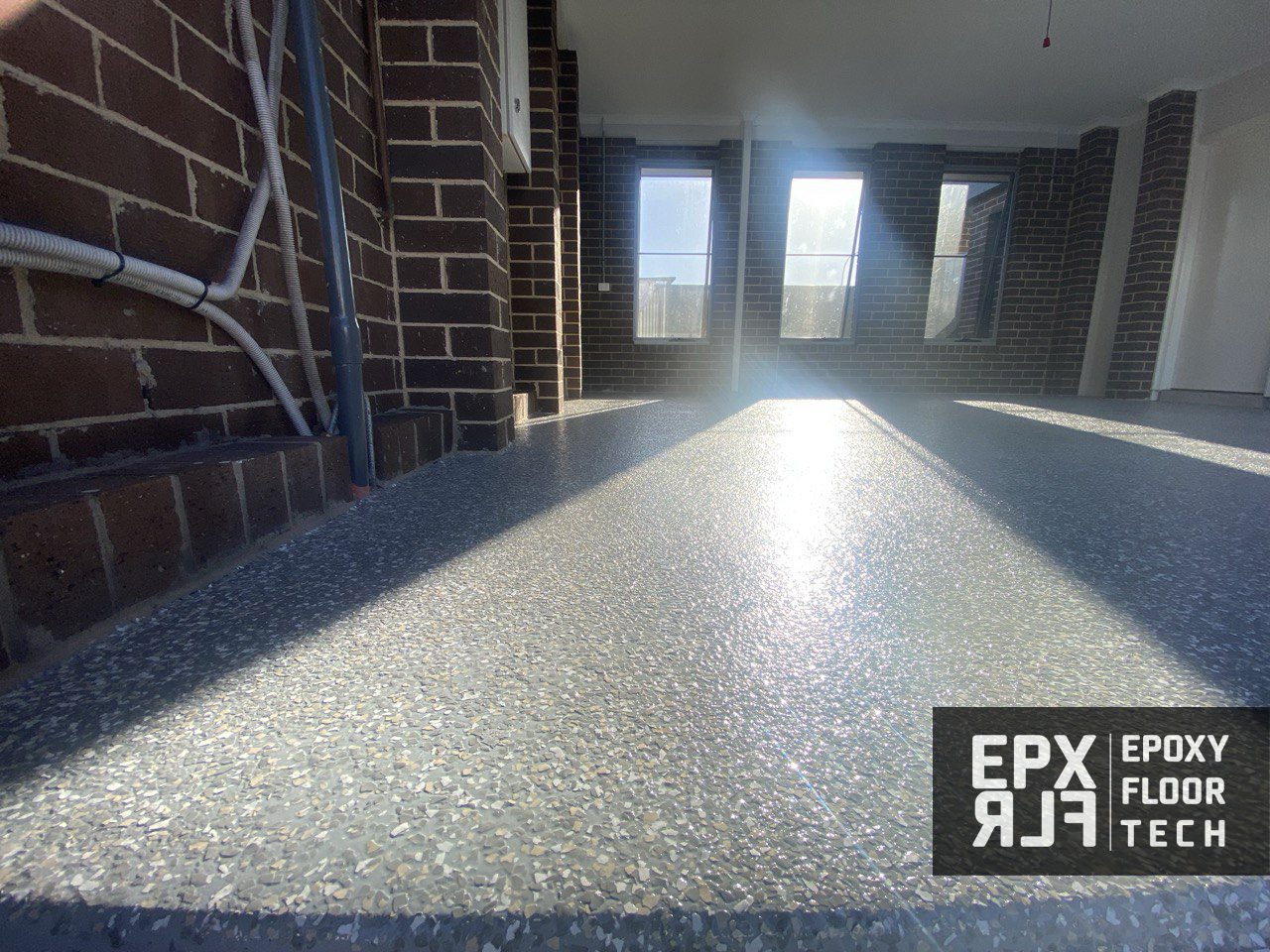
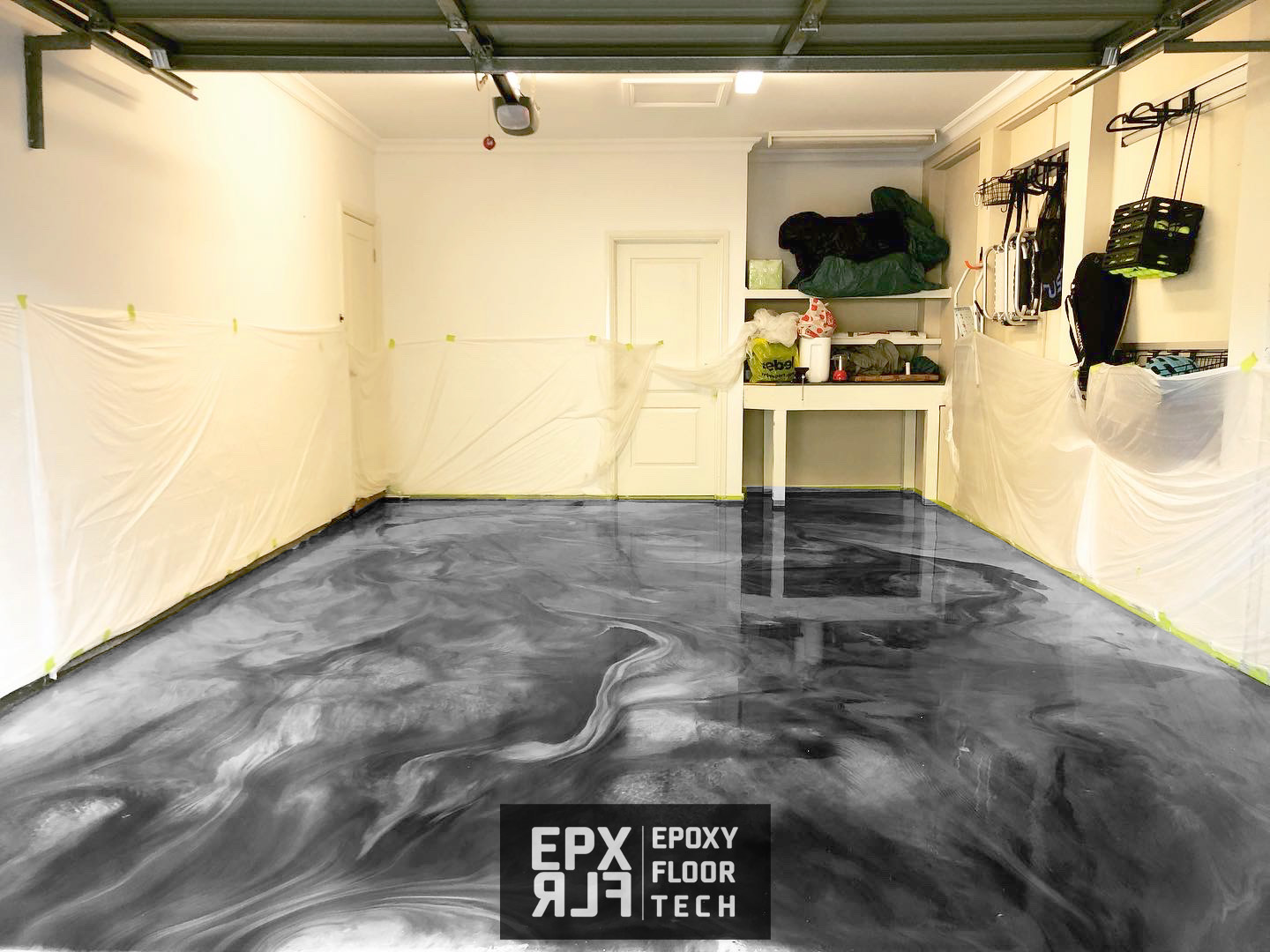
The Installation Process
Installing epoxy flooring is a precise, multi-step process that demands professional expertise. Poor preparation or shortcuts almost always lead to peeling, bubbling, or premature failure. Here’s what a proper installation involves:
Step 1: Surface Preparation
This is the single most critical stage.
Concrete must be mechanically ground or shot-blasted to remove laitance, oil, and contaminants. The surface should have a specific profile (CSP 2–3) to allow the epoxy to bond effectively. Any cracks or joints are repaired with epoxy fillers, and the surface is vacuumed clean.
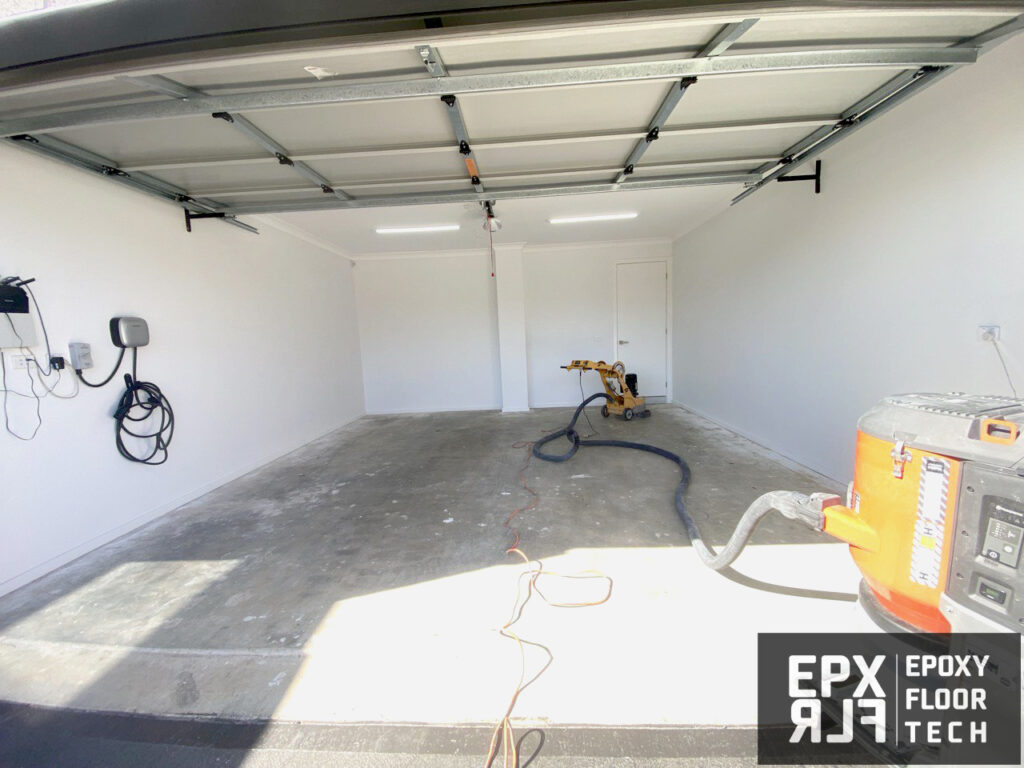
Step 2: Primer Application
A low-viscosity primer penetrates into the concrete pores, forming the foundation for adhesion. The primer may also act as a moisture barrier, preventing bubbling caused by vapor migration.
Step 3: Base Coat Application
Once the primer cures, a thicker base layer of epoxy is applied—typically self-leveling for a smooth finish. At this stage, decorative flakes or metallic pigments may be added, depending on the system design.
Step 4: Aggregate Broadcast (Optional)
For slip-resistant finishes, sand, quartz, or polymer flakes are broadcast evenly over the wet base coat and allowed to settle as it cures.
Step 5: Topcoat Sealer
Finally, a clear or tinted topcoat is applied to encapsulate the aggregates, add gloss, and enhance resistance to abrasion and chemicals. In sunlight-exposed garages, a UV-stable polyurethane topcoat is recommended to prevent yellowing.
Step 6: Curing and Inspection
Curing times vary depending on the epoxy formulation and ambient conditions:
- Light foot traffic: 24–48 hours
- Vehicle use: 3–7 days
After full cure, the surface is inspected for gloss, adhesion, and uniformity.
Maintenance and Longevity
One of the main appeals of epoxy flooring is its minimal maintenance requirement.
To preserve its appearance and performance:
Daily or Weekly Cleaning
- Sweep or vacuum to remove dust and grit.
- Mop with warm water and mild pH-neutral detergent.
- Avoid abrasive pads or acidic cleaners.
Periodic Deep Cleaning
Use a soft-bristle scrubber to lift embedded dirt or tire marks.
For large garages, an auto-scrubber with soft brushes is effective.
Preventive Care
- Place mats under tires if vehicles are parked hot.
- Clean chemical spills promptly.
- Avoid dragging metal tools or jacks without protection.
When maintained properly, epoxy floors can easily last 15–20 years in residential settings and 10–15 years in commercial garages.
Common Problems and How to Avoid Them
Even the best materials can fail if improperly installed.
Here are typical issues and their causes:
|
Problem |
Likely Cause |
Prevention |
|
Peeling or Bubbling |
Inadequate surface prep or moisture trapped beneath coating |
Grind thoroughly; apply moisture barrier primer |
|
Yellowing or Fading |
UV exposure from sunlight |
Use UV-stable polyurethane topcoat |
|
Uneven Gloss or Colour |
Poor mixing or inconsistent application |
Use calibrated mixing ratios and maintain wet edges |
|
Slippery Surface |
Smooth finish without aggregates |
Add anti-slip texture (silica, flakes, or quartz) |
|
Tire Marks |
Hot tire pickup from low-quality epoxy |
Use industrial-grade epoxy with strong bond strength |
Choosing an experienced installer dramatically reduces these risks and ensures compliance with Australian standards.
Cost of Garage Epoxy Flooring (Australia)
Pricing depends on the system type, preparation work, and area size, but general estimates in AUD are:
|
System Type |
Typical Cost per m² |
Description |
|
Basic Solid Colour Epoxy |
$60–$80 |
Smooth, clean finish; optional anti-slip |
|
Flake Epoxy System |
$80–$120 |
Decorative, textured, most common residential option |
|
Metallic Epoxy |
$120–$200 |
Premium designer look |
|
Quartz / Industrial |
$110–$150 |
Enhanced traction and durability |
|
Urethane Cement |
$130–$180 |
Heavy-duty, chemical & thermal resistant |
Note: Preparation (grinding, crack repair) adds approximately $15–$25/m², depending on concrete condition.
Need Garage Epoxy Flooring in Sydney?
Fast Quotes for Garage Epoxy Floors
Environmental and Safety Considerations
Modern epoxy formulations are increasingly eco-conscious, with low or zero volatile organic compounds (VOCs). When installed and cured properly, epoxy floors are non-toxic and inert, emitting no harmful gases.
WARNING: Epoxy resin and/or hardener might be hazardous materials. Read safety datasheets prior to any application and being in contact with them. For general information, read SafeWorks Australia’s page on Epoxies.
For enclosed garages, ensure adequate ventilation during installation to dissipate any temporary odours. Slip-resistant aggregates can also improve overall safety, reducing the risk of workplace or household injuries.
DIY vs Professional Installation
While DIY epoxy kits are widely available, professional systems deliver significantly better results.
| Aspect | DIY Kit | Professional System |
| Thickness | ~0.3 mm (thin paint) | 2–5 mm (true coating) |
| Durability | 1–3 years | 10–20 years |
| Prep Equipment | Basic etching acid | Industrial diamond grinders |
| Finish Quality | Variable | Smooth, even, long-lasting |
| Cost | Lower upfront | Higher initial, far lower lifetime cost |

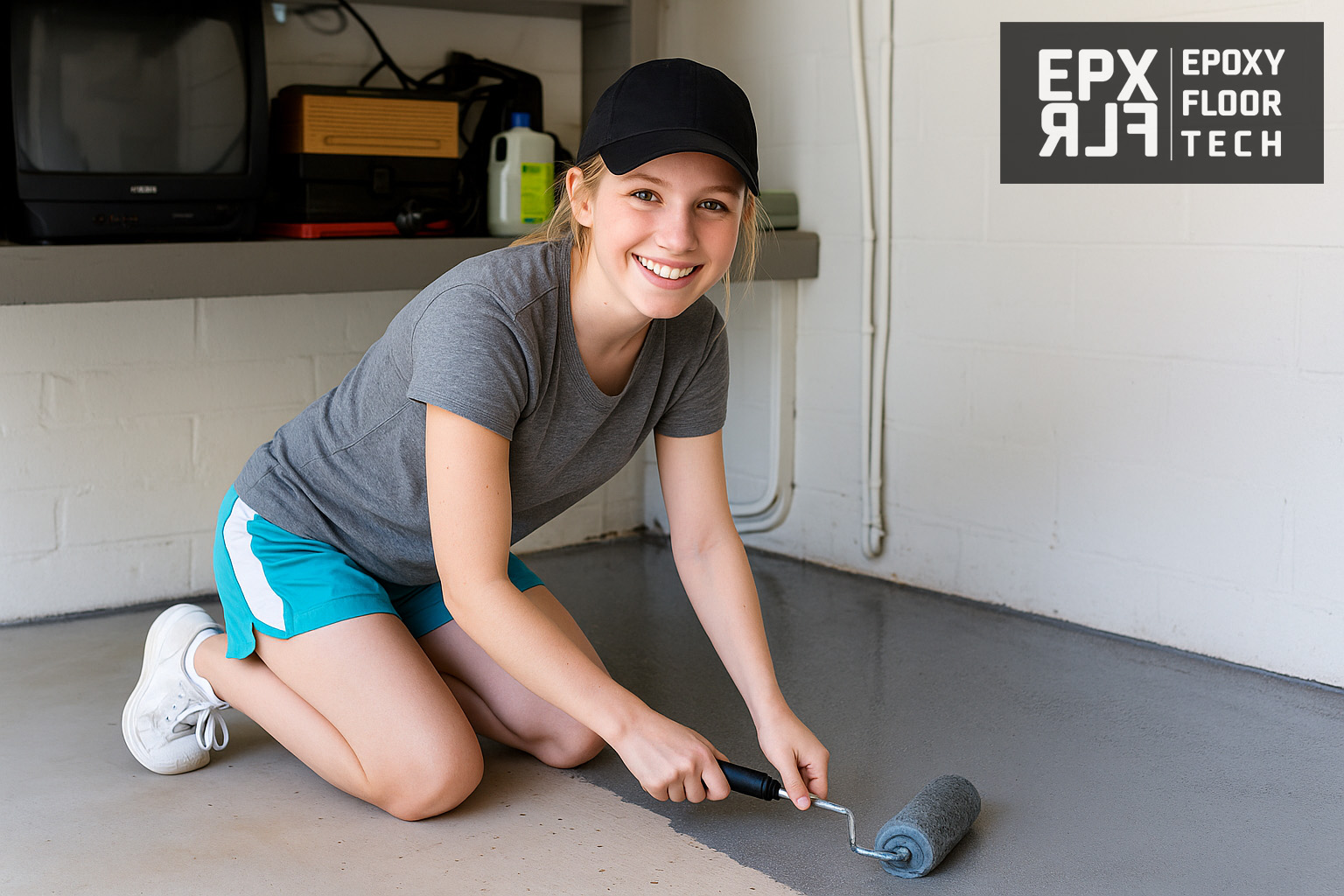
DIY systems often peel within months due to poor adhesion or inadequate surface prep. For garages intended to last decades, a professional installation is the only way to achieve industrial-grade results.
Read more on why DIY epoxy floors fail here. We have explained all contributing factors and how they affect the DIY applications adversely.
Garage Epoxy Design Inspirations
Epoxy flooring allows you to turn a garage into a visually striking, multipurpose environment. Popular design ideas include:
- Two-tone zones: Parking bays in grey, workshop zones in darker charcoal.
- Metallic swirls: For luxury car collections or show garages.
- Flake blends: Natural stone-inspired looks that disguise dust and wear.
- Custom graphics or stripes: For branding or motorsport themes.
Some homeowners even integrate LED floor lighting beneath clear epoxy topcoats for a futuristic appearance.
How to Choose the Right Installer
Selecting a qualified installer is critical. Look for contractors who:
- Specialise in commercial-grade epoxy systems (not just floor paint)
- Offer site preparation with mechanical grinding
- Provide a written warranty (5–10 years typical)
- Use Australian Standard-compliant materials
- Can provide real project references or photos
Reputable installers will also test for moisture vapour emission before coating, a vital step in preventing delamination.
The Future of Garage Flooring
Epoxy flooring continues to evolve with nano-additive resins, UV-stable formulations, and antimicrobial coatings that actively resist mould and bacteria.
New hybrid systems—like polyaspartic epoxies—offer ultra-fast curing times, allowing same-day installations without compromising performance.
In both residential and commercial settings, epoxy flooring is fast becoming the standard for garages that demand strength, hygiene, and style in equal measure.
Conclusion: The Ultimate Garage Transformation
Conclusion: The Ultimate Garage Transformation
A garage floor is more than a surface—it’s a reflection of how seriously you take your space.
With epoxy flooring, homeowners and businesses alike gain a durable, hygienic, and visually impressive foundation that stands the test of time.
Whether you’re a car enthusiast, a tradesperson, or simply someone who values order and aesthetics, epoxy flooring elevates your garage from ordinary to exceptional.
TL;DR
Epoxy flooring offers unmatched durability, chemical resistance, and aesthetics for garages. It seals concrete against stains and moisture, resists wear from vehicles and tools, and can last up to two decades with minimal maintenance. With options ranging from solid colour to metallic and flake finishes, epoxy provides the perfect balance between beauty and performance—making it the ultimate garage upgrade.